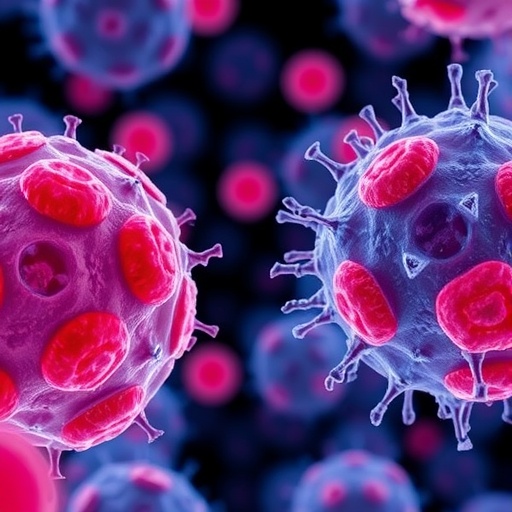In a groundbreaking study published in the Journal of Translational Medicine, researchers have unveiled a fascinating interaction between red blood cells (RBCs) and circulating tumor cells (CTCs), shedding light on a potential new pathway that could facilitate cancer metastasis. This research stands as a testament to the intricate workings of the human body, unveiling how seemingly benign cellular components can play a pivotal role in the progression of cancer. The findings could have significant implications for understanding cancer biology and developing novel therapeutic strategies.
The study draws attention to the ever-evolving landscape of cancer research, where it is increasingly recognized that the tumor microenvironment is far more complex than previously imagined. The research team, led by J. Richert and colleagues, meticulously analyzed clinical and molecular evidence to propose a model in which RBCs might unwittingly aid CTCs in their journey through the bloodstream, potentially enhancing their metastatic capabilities. This revelation could open new avenues for therapeutic intervention, targeting this interaction to inhibit cancer spread.
RBCs, traditionally viewed merely as carriers of oxygen, are now being recognized for their potential to influence cancer cells. The study explores how these cells create a hospitable environment for CTCs by altering their physical and biochemical characteristics. By doing so, RBCs might enhance the survival of CTCs as they traverse the circulatory system, escaping the immune system’s surveillance and increasing their chances of lodging in distant organs where they can establish new tumors.
Moreover, the researchers focused on the molecular interactions between RBCs and CTCs, discovering that specific molecular signals could facilitate the attachment of CTCs to RBCs. This attachment process could aid CTCs in evading immune detection and may even facilitate their extravasation—the process by which they exit the bloodstream to invade surrounding tissues. Such findings highlight the dual role of RBCs in both normal physiology and their potentially harmful influence in cancer progression.
In the experimental phase of their research, the team employed a variety of advanced techniques, including flow cytometry and confocal microscopy, to visualize the interactions between RBCs and CTCs. These methodologies provided compelling evidence of physical associations and prompted further investigation into the specific signaling pathways involved. The data suggest that certain surface proteins on RBCs might play a critical role in mediating binding with CTCs, thereby marking a significant step forward in understanding tumor dissemination.
One of the critical implications of these findings lies in the potential to target this RBC-CTC interaction in future therapies. By disrupting the molecular signals that promote this association, researchers may be able to devise strategies that significantly reduce metastasis and improve patient outcomes. This therapeutic approach could be particularly relevant for patients with aggressive forms of cancer, where metastasis is the leading cause of mortality.
As the scientific community begins to grapple with these insights, future studies will undoubtedly be aimed at elucidating the precise mechanisms underpinning this interaction. Researchers are keen to delve deeper into the genetic and epigenetic alterations in both RBCs and CTCs that may influence this interplay. Understanding the molecular underpinnings could lay the groundwork for innovative ways to manipulate this relationship in favor of patient health.
Additionally, the clinical implications of this research cannot be overstated. Cancer metastasis remains a significant challenge in oncology, often leading to treatment resistance and poor prognosis. The newly proposed model underscores the necessity of an integrated approach to cancer treatment, one that considers the entire ecosystem of tumor cells, including the role of RBCs. This holistic approach could refine therapeutic strategies and enhance their efficacy in clinical settings.
Moreover, researchers are exploring how systemic factors, such as inflammation and anemia, might influence the RBC-CTC interaction and consequently impact patient outcomes. Understanding these systemic interactions can provide a more comprehensive view of how cancer spreads and may lead to improved diagnostic and prognostic tools in the future.
As this area of research continues to unfold, it becomes essential to engage in interdisciplinary collaborations. By bringing together experts in hematology, oncology, and molecular biology, the scientific community can foster a more nuanced understanding of the role of RBCs beyond their traditional functions. Collaborative efforts can accelerate the translation of these findings from bench to bedside, ensuring that patients benefit from cutting-edge research.
In conclusion, the study by Richert et al. presents a compelling narrative about the interaction between red blood cells and circulating tumor cells, proposing a potential pro-metastatic axis that warrants further exploration. As researchers continue to unravel the complexities of this relationship, the hope remains that such insights will pave the way for novel therapeutic strategies that could dramatically alter the landscape of cancer treatment. The journey from understanding this intricate cellular interplay to applying it in clinical practice will require concerted effort, but the potential benefits for patients could be monumental.
As we move forward, a call to action emerges for researchers and clinicians alike: to deepen investigations into the myriad ways that our body’s cellular components interact and impact disease processes. Only through such thorough exploration and inquiry can we hope to combat the formidable challenge that cancer presents, ultimately ensuring better treatment outcomes for patients across the globe.
This dynamic field of study serves as a reminder of the marvels of biology and the importance of continued research to uncover the hidden complexities that often dictate health and disease outcomes.
Subject of Research: The interplay between red blood cells and circulating tumor cells in cancer metastasis.
Article Title: Interplay between red blood cells and circulating tumor cells: clinical and molecular evidence of a putative pro-metastatic axis.
Article References:
Richert, J., Popęda, M., Muchlińska, A. et al. Interplay between red blood cells and circulating tumor cells: clinical and molecular evidence of a putative pro-metastatic axis.
J Transl Med 23, 1236 (2025). https://doi.org/10.1186/s12967-025-07255-y
Image Credits: AI Generated
DOI: https://doi.org/10.1186/s12967-025-07255-y
Keywords: Cancer metastasis, circulating tumor cells, red blood cells, tumor microenvironment, molecular interactions, therapeutic strategies.




